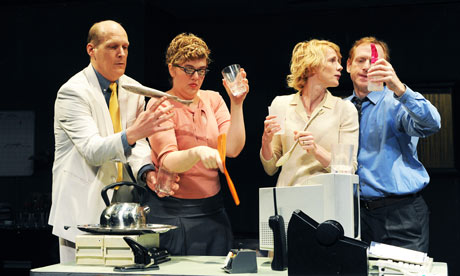
Two artistic marathons are taking place this weekend. Theatregoers at the Norfolk and Norwich festival will sit through a 12-hour experimental play called Life and Times, which chronicles the life of an ordinary young woman in the US. And in Brighton, film fans will watch the final four-hour instalment of Berlin Alexanderplatz, Fassbinder's 15-and-a-half-hour adaptation of one of Germany's best-loved novels. Ticket sales for both events have been good.
Gatz, an eight-hour production in which every single word of The Great Gatsby is read out on stage, was a sellout when it opened in London last summer with the kind of rave reviews Baz Luhrmann can only dream of for his film.
There is nothing new about marathon shows. Peter Brook's Mahabharata was nine hours, and Wagner's Ring Cycle is 15. I can proudly say that in 2008 I saw the RSC's Histories Cycle – all Shakespeare's eight history plays, adding up to 24 hours – performed over one weekend, and I loved it.
What is particular about these cultural marathons is that they are happening now – when we are so distracted by email, Twitter, Facebook, etc, on our smartphones that we've lost the ability to concentrate on one thing only. Most theatre, TV and cinema producers these days work on the assumption that if something isn't action-packed, the YouTube generation won't watch.
But the success of these marathon performances is proof there is a growing audience out there that craves the opportunity to focus on one thing for a long period of time. We're lost in a superficial snowstorm of information where we end up knowing a lot about nothing. Perhaps this explains the success of long-form TV dramas such as The Killing, and the trend for binge-viewing DVD box sets. We are fed up with bouncing from one story to another.
We are seeing the same thing with the revival of long-form journalism. Readers are now lapping up 10,000-word pieces on websites dedicated to the art form. This seems counter-intuitive in a Twitter universe. YouTube snippets may provide instant gratification, but it's almost too easy, there's no challenge, it doesn't make us think – and that can be profoundly unsatisfying in the long run.
In a live performance, being kept in a room for several hours without any other distraction allows us to go deeper and to immerse ourselves totally in what the performers are doing. Pavol Liska, one of the directors of Life and Times, believes we're hungry for a new kind of experience, one that involves making a sustained commitment. "Both the audience and the performers get 12 hours when you can't check your phone. It's about creating time and space where people can just think and be."
DJ Colleen Murphy set up a club called Classic Album Sundays three years ago because she felt iPod users were missing out on the experience of listening to an entire album from start to finish. She tells people to turn off their phones, stop talking, sit still and just listen. Classic vinyl albums such as Pink Floyd's Dark Side of the Moon are then played on a high-quality hi-fi system. Murphy laughingly calls it "audio yoga", and her biggest audience demographic is the shuffle generation: 20- to 29-year-olds.
The communal aspect is also important. My mother-in-law, who is going to the final instalment of Berlin Alexanderplatz on Sunday, says she's bonded with other audience members because they've now spent so much time together. They discuss it in the cinema lobby in a way you never normally do after a 90-minute feature film. If you sit next to someone for several hours you start to observe them, you notice their particular habits, barriers break down and you begin to bond over your shared experience, even if it's just to complain about your sore bum or whether you are going to nip out to check your emails.
Though the audiences for these events remain small, they are growing. It seems that more and more people of all ages are seeking to enter a world beyond 140 characters.

